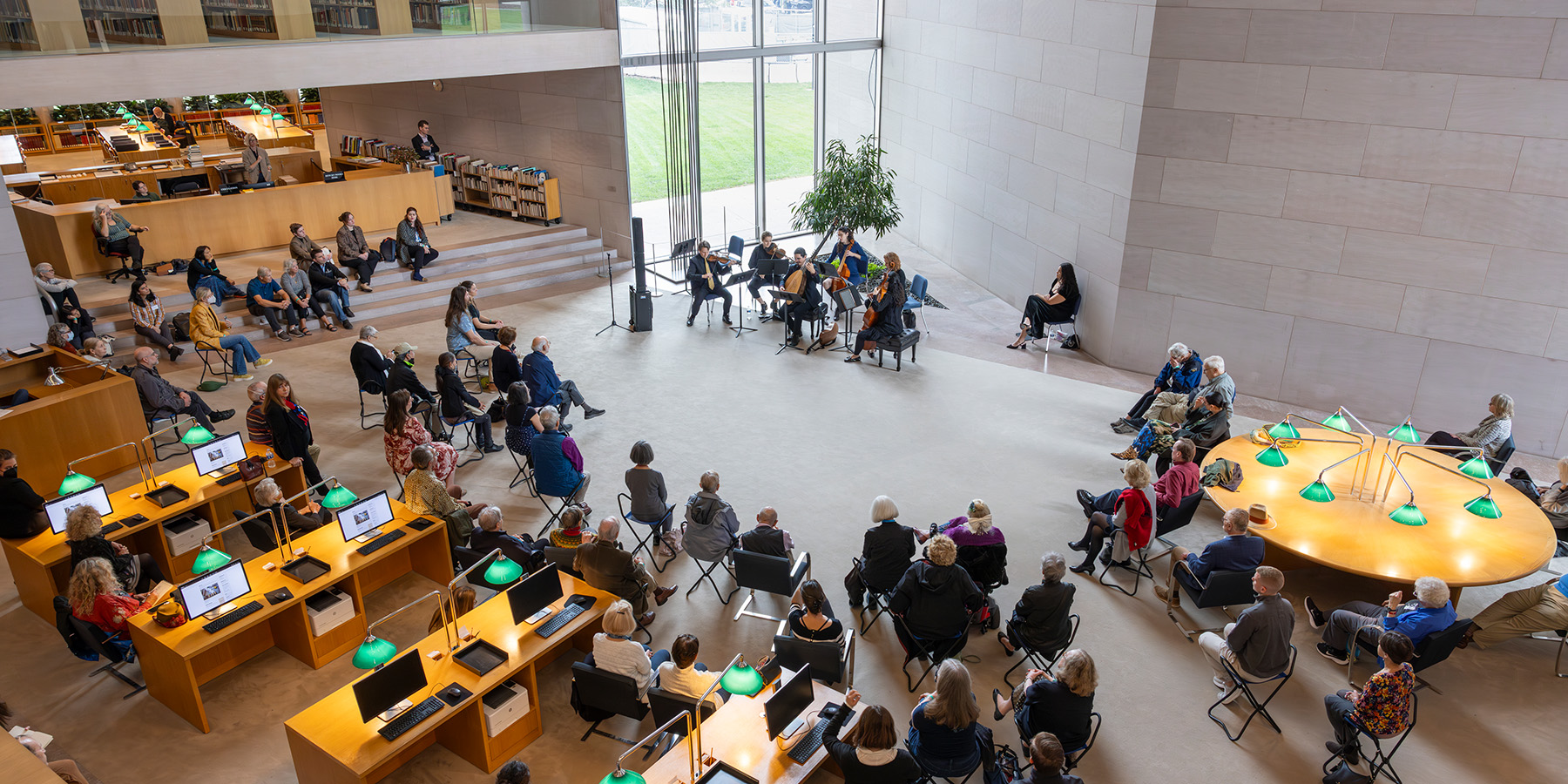Dean’s Report
Steven Nelson
Dean
As the Center’s 44th cohort settled in this past September, we bid farewell to our administrator Helen Tangires, who after 36 years retired from the National Gallery. Throughout her time at the Center, Helen not only kept us on track but also befriended dozens of coworkers, 73 professors, and nearly 1,000 fellows. While we miss her greatly, we are thrilled that she is enjoying her post–National Gallery life. In addition to Helen’s retirement, 2023–2024 was incredibly busy: the Center hosted 43 programs, supported 52 individual projects, and engaged a community of nearly 100 people, from staff to advisory board members to fellows.
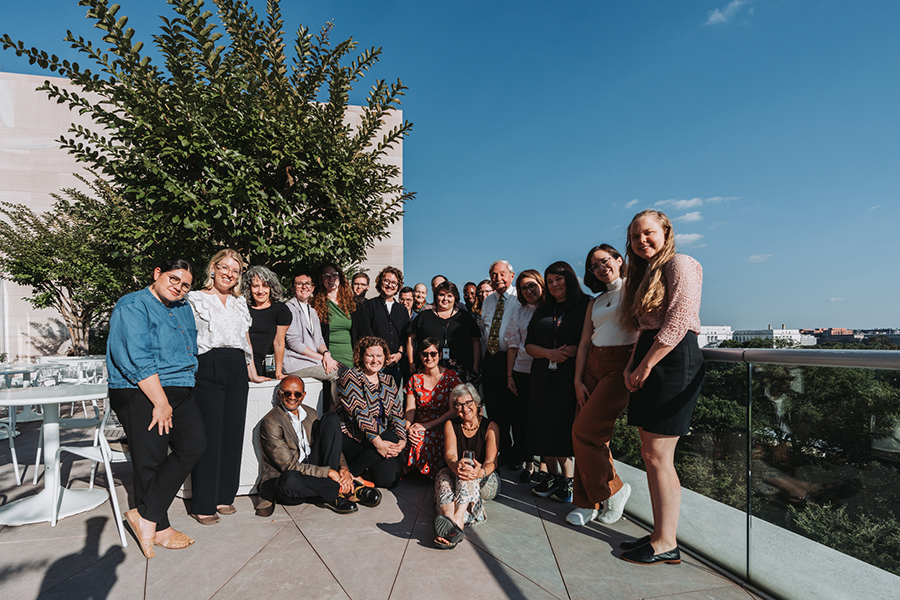
Helen Tangires (center) with members of the Center community, past and present, at her retirement party, October 2023
A wide range of provocative programs, innovative internships, and groundbreaking research is bringing new questions to the study of art and architecture and introducing young people to our professions. This year’s fellows hailed from institutions spanning the United States as well as the Czech Republic, Germany, Italy, Mexico, and Nigeria. Research topics ranged from Soviet architecture, climate science, and the “other” in ancient Neo-Assyrian art to an investigation of bronze’s materiality as it relates to race in 19th-century American sculpture and society. Whether an undergraduate intern learning the basics of art history and museum operations, a predoc conducting dissertation research abroad, or a senior fellow formulating a new project or bringing a text to fruition, the ways in which Center scholars spent their tenures varied nearly as much as their topics of research.
Our fellows’ programs consist of weekly discussions, tours, presentations, and other convenings. This year, our colloquia—talks given by professors and senior fellows, open to the public and streamed online—welcomed over 1,100 attendees. Nancy J. Troy, Kress-Beinecke Professor, inaugurated the academic year with her colloquium titled “Mondrian’s Dress.” In addition to her research on the fundamental role of fashion in making Piet Mondrian’s style instantly recognizable over the past half century, Troy was a model mentor to our predoctoral fellows. Sharing valuable intellectual and professional advice with the cohort, she also arranged visits to Washington-area museums and libraries as well as meetings with early-career curators.
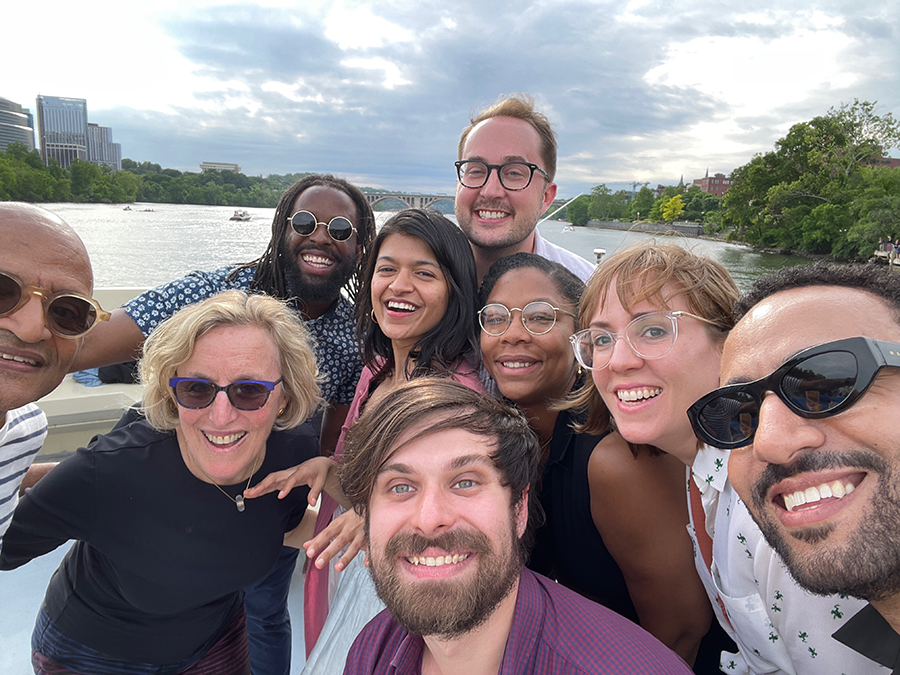
Center predoctoral fellows with Steven Nelson and Nancy J. Troy, Kress-Beinecke Professor (both left), on the Center’s farewell boat tour, May 2024
In her second year as Andrew W. Mellon Professor, Adriana Zavala closed out our colloquium series with “Black Latinx: Radical Unsettling.” Her talk investigated the social, political, economic, and cultural structures that too often erase and exclude Black Latinx people and their histories. This work will appear as a chapter in the forthcoming The Routledge Companion to African Diaspora Art History.
Edmond J. Safra Visiting Professor Pamela H. Smith organized a colloquy on “Thinking through Materials,” with panels and discussions focused on wood, metals, feathers, and human/environment relationships. She gave an inspirational keynote lecture, “Making and Thinking through Human-Material Interactions,” which kicked off the colloquy proceedings and highlighted The Making and Knowing Project, of which she is founding director.
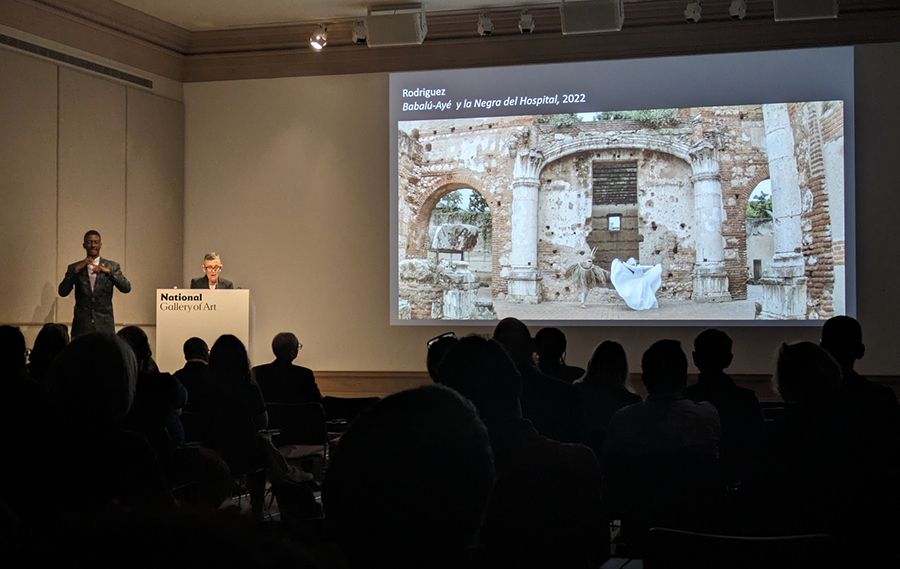
Adriana Zavala, Andrew W. Mellon Professor, presents her colloquium “Black Latinx: Radical Unsettling,” with ASL interpretation, April 2024
Smith’s research on the history of science and nature resonated strongly with the Center’s first visiting guest artist, Dario Robleto, who worked on a film project for the exhibition Little Beasts: Art, Wonder, and the Natural World, opening at the National Gallery in May 2025. Robleto’s residency coincided with the installation of his work Small Crafts on Sisyphean Seas, recently acquired by the National Gallery, in our Dutch galleries. In the gallery, Robleto spoke about his work with the SETI (search for extraterrestrial intelligence) Institute and how Small Crafts imagines a gift to extraterrestrials to best represent planet Earth.
Our 2022–2024 Howard University undergraduate interns (Keauna Brantley, Amaya Charley, Dana Goodridge, Kennedy Martin, Sacha Reid, and Munyang Tengen) finished their second year of the program, joining several National Gallery departments to support projects that advance institutional goals while building the interns’ professional skills. In addition, the cohort continued to come together for community events, such as lunches with other interns at the National Gallery, professional development seminars, and museum visits. One memorable event was a visit to the Baltimore Museum of Art for a tour of The Culture: Hip Hop and Contemporary Art in the 21st Century with one of the exhibition designers, Julian Arrington. As I write these reflections, the group is attending the 2024 Association of African American Museums annual conference in Baltimore. Our 2023–2025 interns (Jada Brooks, Clay Cauley, Aletheia Couts, Miles Kenyan Stewart, Elroi Yonatan, and Aneesah Lawrence) participated in weekly seminars that introduced topics in art history, museum studies, and related fields along with a focus on professional exploration and skills-building. They interacted with colleagues from the National Gallery and other institutions through exhibition tours, department and institutional visits, research-in-progress and career spotlights, and hands-on activities. In January, the cohort visited New York City, meeting with staff from the Metropolitan Museum of Art and Stavros Niarchos Foundation Library and engaging with collections at the Morgan Library & Museum and El Museo del Barrio.
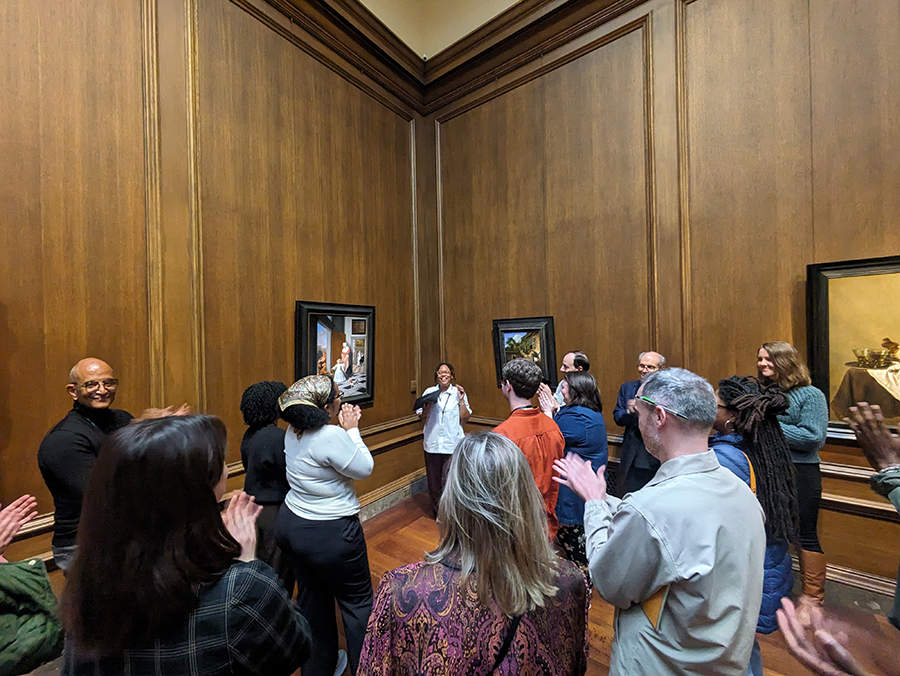
Jada Brooks, Howard University undergraduate intern, presents her gallery talk to the Center and National Gallery staff, April 2024
This year’s academic programs began with music and ended with theater. In October, the Center cohosted a multiday, two-location conference with the Juilliard School. Organized with Eve Straussman-Pflanzer, curator and head of the department of Italian and Spanish paintings at the National Gallery, and Elizabeth Weinfield, musicologist and faculty member at Juilliard, Women in Art and Music: An Early Modern Global Conference featured scholarly presentations and musical performances focused on women in a myriad of roles in the early modern period. The conference celebrated the National Gallery’s acquisition of a painting by Italian artist Lavinia Fontana, which depicts the 16th-century musician Lucia Bonasoni Garzoni. The program activated spaces across the National Gallery with performances from students of Juilliard’s Historical Performance program and the ensemble Sonnambula. Displaying Fontana’s portrait outside of the National Gallery’s East Building Auditorium further added to the multidisciplinary, multi-sensorial nature of this conference.
In the spring, actress, playwright, and professor Anna Deavere Smith delivered the 73rd A. W. Mellon Lectures in the Fine Arts, Chasing That Which Is Not Me / Chasing That Which Is Me, to a full house for all four presentations. Her historic lectures—the first in the long-running series by an actress and playwright—interweaved performances and experiences that she has crafted over the course of her career. In addition to dialogues with the Center community, Smith hosted a Q&A for National Gallery staff.
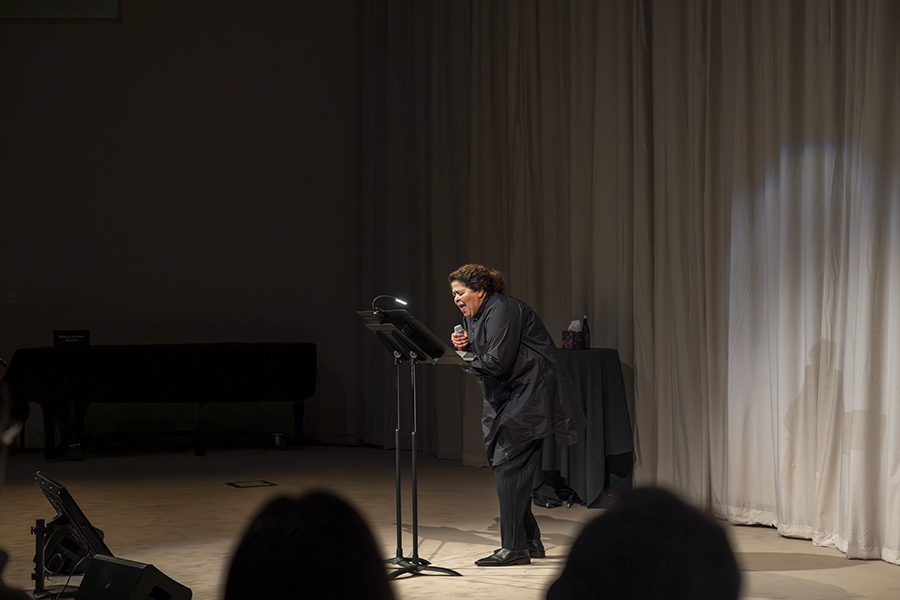
Anna Deavere Smith presents the 73rd A. W. Mellon Lectures in the Fine Arts, May 2024
Beyond the Mellon Lectures, we continue to support lecture series that feature innovative research in the fields of Italian and American art. In November, Michael Cole of Columbia University delivered the 27th annual Sydney J. Freedberg Lecture on Italian Art, entitled “Sofonisba Anguissola: Recent Discoveries and Debates.” The following month, we welcomed Roberto Tejada of the University of Houston for the biannual Wyeth Lecture in American Art, presenting the talk “Latinx Art and the Intimacy of Dislocation.” Both Cole and Tejada elaborated on their research in dialogues with the Center community following their talks. Video recordings of their lectures are available of the National Gallery Talks YouTube channel.
In its 54th year, the Center cosponsored with the University of Maryland the Middle Atlantic Symposium in the History of Art. Held each March, it features a day of presentations by graduate students from the mid-Atlantic region. Kicking off the symposium in College Park, professor at Tulane University (and former Center visiting senior fellow) Stephanie Porras delivered the annual George Levitine Lecture in Art History, titled “How Not to Do Global Art History.”
This fall, I moderated a discussion on the Center’s newest Seminar Papers volume, Black Modernisms in the Transatlantic World, with my coeditor Huey Copeland and contributing author Kellie Jones. This was followed by a book signing. Black Modernisms received the 2024 James A. Porter and David C. Driskell Award in African American Art History from the University of Maryland’s David C. Driskell Center, and the volume has gone into a second printing. We continue work on the next Seminar Papers volume, Academies of Art in Europe and the Americas, 1600–1900, edited by associate dean Peter M. Lukehart, Ulrich Pfisterer, and Oscar E. Vázquez.

Aleksander Musiał leads a discussion in the National Gallery’s print study room, March 2024
The Center, the National Gallery’s video production team, and former Edmond J. Safra Visiting Professor Aruna D’Souza have collaborated on a new video series: 5 Pictures for a New World. D’Souza selected five works in the National Gallery’s collection that, to her, hold a promise for a better future. The resulting videos are inspiring, showing how art and artists create more empathetic worlds. They also beautifully illustrate the possibilities inherent in connecting research and scholarship to the world in ways that move us to understand our surroundings differently. This is true, I would like to think, of much of the Center’s work. It is certainly a lofty—and attainable—goal.
